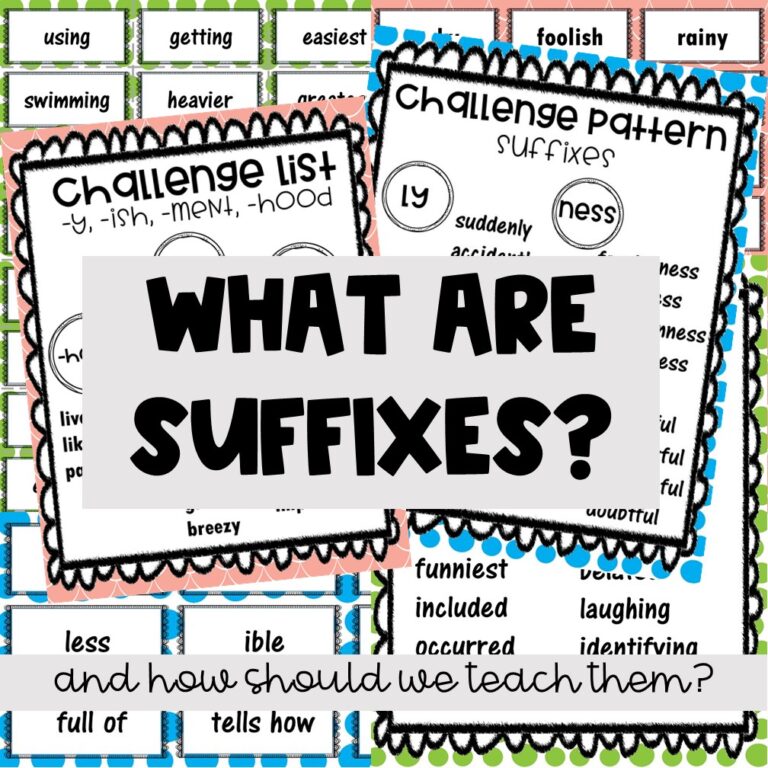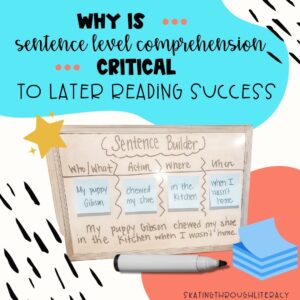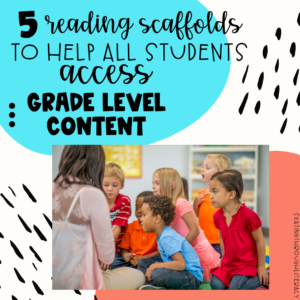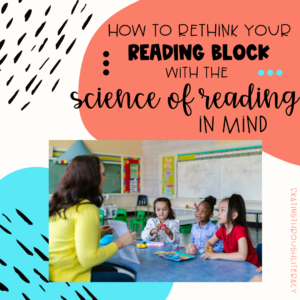So it is time to tackle teaching suffixes in your classroom, but you don’t know where to start! There are 26 different suffixes in the English language. That’s as many suffixes as there are letters in the alphabet. So where do you start? In this blog post I will walk you through how to begin teaching these to your students in a meaningful and concrete way.
First, we have to know as teachers what are suffixes? And how do they change the meaning of a word? Traditionally, suffixes have been taught through a given spelling list. Students receive a list of words, practice them for a week, and take a test on Friday. However, unlike other spelling patterns that children tackle in earlier grades, adding suffixes to base words is more than simply memorizing a string of letters that go together. Students have to understand that a suffix meaning can change a root word. Suffixes can, and do, change the meaning of the word it is attached to. Teaching the meaning is crucial to students comprehension of a text. If a suffix is added to a word they already know and understand, the addition of the suffix could change that meaning.
Start at the beginning
Often times the first suffixes children run into are not presented to them as suffixes. These suffix examples include -s, -es, -ed, -er, and -ing. In the beginning, students often learn these as a way to make a word plural. Or a way to change the tense of a verb. In these examples, adding the suffix often changes the word to a new form of speech. For example run with the suffix of -er added changes run from a verb to runner, now a noun. When adding these common suffixes, students also need to be taught the rules governing the spelling patterns. Begin by explicitly teaching these common spelling rules which children will encounter most:
- when a word ends in a closed syllable with a short vowel sound, double the last consonant before adding the suffix
- if a word ends in a VCe syllable, drop the e before adding the suffix
- when a word ends with a consonant then y, change the y to an i before adding the suffix
- if a word ends with a vowel then y, leave the y then add the suffix
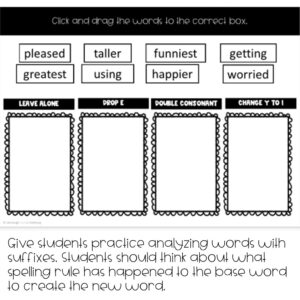
Grab your copy of this interactive word sort as part of my digital word work for introducing suffixes.
If students struggle with identifying spelling rules through word sorts, then more explicit instruction and practice is needed. I suggest for students to focus on one pattern or one suffix at a time. By providing multiple examples of the same rule it allows a student to focus on one pattern at a time.
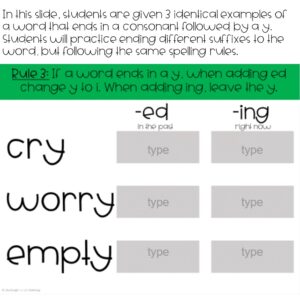
Students must first master these basic spelling rules for adding a suffix to the end of the word. Failure to master these rules can account for many common spelling errors you may see in student from grades 2 and 3 and beyond. Common mistakes like “stoped” and “runing” are indicators that these rules have not yet been understood by a student.
Adding On the Next Level
Once students have been exposed to the most common suffixes of -s, -ed, -ing, -er, and -est and become familiar with the spelling rules, it’s time to add on a few new ones at a time. By only introducing a handful at once, students can focus on the suffixes definition. This will allow them to focus on meaning word chunks rather than rote memorization. My next suggestion for explicit instruction would be -ful, -ly, -less, and -ness. These are common in the English language and begin to show up in students reading material more frequently.
By being able to identify these suffixes, students are more likely to be successful decoding unknown multi-syllabic words they come across in reading. You can use this resource below for students to practice identifying what suffixes mean in isolation, before adding them to a given base word.
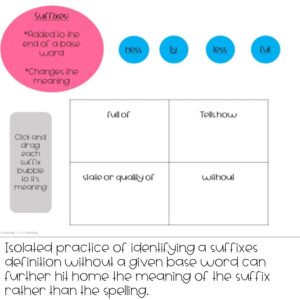
Meaning Matters
Remember to focus instruction on the meaning of the suffixes. When students focus on the suffix meaning, they will begin to understand that you cannot add any suffix to any base word. Your students need practice determining which suffixes can be added to base words by determining what makes sense.
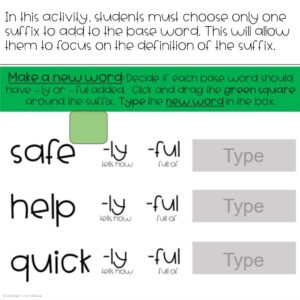
Continue teaching a few suffixes at a time
Once students have become familiar with these first few suffixes meaning, you can continue teaching new ones a few at a time. I suggest the grouping of -y, -ment, -ish, and -hood as the next common suffixes to introduce to students.

This table is available in my digital word work for focusing specifically on -y, -ment, -ish, and -hood. You can snag your own copy here for students to practice matching up base words and root words.
Incorporating Grammar when teaching Suffixes
Another way to teach students what suffixes mean is by focusing on how the addition of a suffix can change the words part of speech. For example by adding -er, -or, -ist, and -ess to a word, the word changes from a verb to a noun, a person.
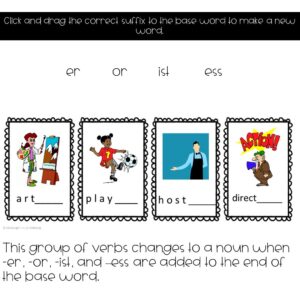
Putting It All Together
As you continue to introduce your students to suffix meaning, don’t forget to circle back to previously introduced suffixes. The more activities students can practice what suffixes mean, the more this will improve overall comprehension and spelling abilities.
Check out the shop my store page to see all the resources available mentioned here to help you tackle teaching your students all about suffixes.

